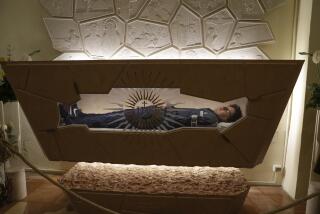Catholic Church Launches On-Line Mission to Cyberspace
- Share via
NEWARK, N.J. — Between the sordid cyberporn and the electro-babble that ooze and echo along the Internet, add a new element: professions of faith and illuminated manuscripts.
The Roman Catholic Church is on-line.
Propelled by the public relations bonanza of Pope John Paul II’s imminent visit to the United States, the church is sending missionaries into cyberspace, establishing a beachhead in its most otherworldly venue to date.
“This is another way of communicating, and I don’t think we can ignore it,” said Ron Pihokker, an Archdiocese of Newark official charged with developing electronic educational material. “Especially since computers are the language our kids speak today.”
On Wednesday, the Holy See announced the creation of its home page on the Internet, created by a team of students from the New Jersey Institute of Technology in Newark. (The Internet address for the Vatican’s home page is https://www.catholic.net)
Rushing to fill the electronic void are a host of official and unofficial Catholic information outlets, offering everything from an Electronic Scriptorium to the Shroud of Turin home page.
The movement to this medium, observers say, is driven by economics, a dawning awareness of the technology’s vast dimensions and, last but not least, the desire to be cool.
“People don’t realize that the church already spends a huge amount in marketing and advertising,” said Peter Conway, president and CEO of a Virginia software company creating a new Catholic on-line service. “Now the church can do the same thing on the net that they do on TV for much less money. And they can reach many more people.”
The fact that this computer-literate Internet audience is also predominantly young is not lost on church leaders.
“The Protestants have done a really good job of attracting youth,” said Mike Galloway, a former film producer who founded one of the new Catholic on-line services. “This is something the Catholic Church hasn’t done as well.”
Until now. Church officials readily concede that this large-scale electronic venture is their best shot.
Galloway, who produced documentaries on Catholic subjects, worked with Cardinal Roger Mahony of Los Angeles to get the Pontifical Council for Social Communications--the branch of the Vatican that oversees the worldwide Catholic media--and U.S. Catholic Conference to approve an official church site on-line.
Known as Catholic Online, the system went up in February, and already its home page has attracted about 100,000 inquiries. Its users can download items from the 30,000-document library, talk to a priest on-line or chat with Catholic singles.
Last weekend, Catholic Online unveiled the Catholic Education Network--a listing of all 19,000 Catholic schools in America. And on the drawing board are “celebrity guest appearances” by Vatican-based priests and other church officials.
Thomas Terry, a New Jersey Institute of Technology computer expert who has helped design one of the church’s fledgling forays into the electronic medium, said that church officials have been worried that the snazzy graphics typical of some computer programs might cloud the religious message.
The World Wide Web site he helped design--called the Catholic Information Center on the Internet--will offer, among other things, continuous videos and stills of John Paul’s October visit to Newark, as well as details of his itinerary and the full text of his remarks at each stop of his tour.
Perhaps the most telling sign of the church’s understanding of cyberspace is the Electronic Scriptorium.
About 75 miles north of Santa Fe, N.M., at the end of a nameless road that the brothers call their driveway sits the Monastery of Christ in the Desert. The Archdiocese of Santa Fe says the brothers at this Benedictine retreat have no telephone.
But they do have computers.
When not praying, the brothers support themselves by working in the Electronic Scriptorium, using computers to design elaborately colorful home pages for themselves and the businesses to which they offer their services.
“We don’t have any parchment on hand . . . we write on electrons, creating cyberbooks--pages for the World Wide Web,” the monastery’s home page explains. “After all, we’ve been making pages for 1,500 years. It’s part of our tradition, our heritage as monks.”
Still, the wheels of progress turn slowly for some church officials more set in their ways.
“These young priests will give you their e-mail address if they want to keep in touch, which is something I just wouldn’t think of,” mused Father Matthew, an archival worker in the Apostolic Nuncio in Washington.
“I’m still getting used to my electric typewriter.”
More to Read
Sign up for Essential California
The most important California stories and recommendations in your inbox every morning.
You may occasionally receive promotional content from the Los Angeles Times.







